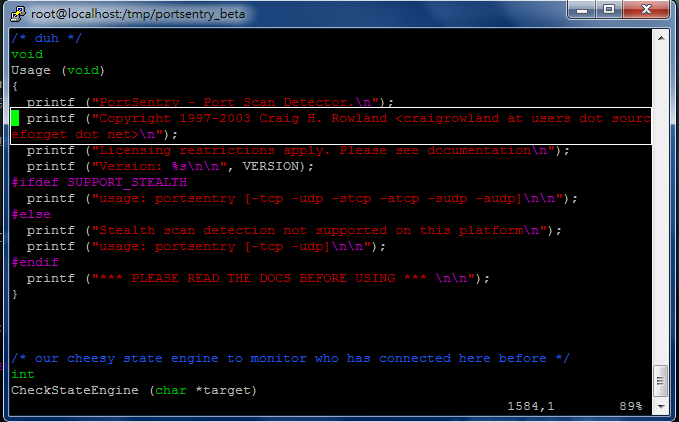

- #HOW TO INSTALL PORTSENTRY ON CENTOS HOW TO#
- #HOW TO INSTALL PORTSENTRY ON CENTOS SOFTWARE#
- #HOW TO INSTALL PORTSENTRY ON CENTOS CODE#
- #HOW TO INSTALL PORTSENTRY ON CENTOS ISO#
#HOW TO INSTALL PORTSENTRY ON CENTOS HOW TO#
In this article, you will learn how to install KVM virtualization, create and manage Virtual Machines in CentOS 8 and RHEL 8 Linux. Some of its key features include support for a wide range of Linux-supported hardware platforms (x86 hardware with virtualization extensions (Intel VT or AMD-V)), it provides enhanced VM security and isolation using both SELinux and secure virtualization (sVirt), it inherits kernel memory management features, and it supports both offline and real-time migration (migration of a running VM between physical hosts). It also supports nested virtualization, which allows you to run a VM inside another VM. Under KVM, each VM is a Linux process that is scheduled and managed by the kernel and has private virtualized hardware (i.e CPU, network card, disk, etc.). It is a loadable kernel module that turns Linux into a type-1 (bare-metal) hypervisor that creates a virtual operating platform used to run virtual machines (VMs). If you have any other source of installation, then you can put the path accordingly.Kernel-based Virtual Machine ( KVM in short) is an open-source and de facto standard virtualization solution that is tightly integrated into Linux. Installation Source will be Auto-detected installation media. Choose a language and click on the + icon to add more keyboard layout. Now change the Keyboard settings by clicking the KEYBOARD.Ī window will appear. Change settings one by one according to your needs.Ĭlick on DATE & TIME and change the place in the map and click on Done.Ī map will appear, and select your time zone. The installation summary window will appear with lots of options present. Select the language appropriately to use during installation and press Continue. The system would start loading the media installer. Select “Install CentOS 7” and press Enter Key. Place the created USB into the appropriate drive, start your computer, select the bootable unit and a window shown below will appear.

# dd if=/iso/CentOS-7-x86_6-99.iso of=/dev/sdbĮnsure that you have at least 4.3 GB of free space in your USB.
#HOW TO INSTALL PORTSENTRY ON CENTOS ISO#
Simply transfer the iso file to USB using the dd command, or you can use Win32DiskImager or Etcher. Select which image is suitable for your system or according to your need. Armhfp and aarch64 are supported in version 7 of CentOS. Architecture ia64, ppc, SPARC, Alpha and s390 are supported only in version 4. Different architectures support in different versions like i386 systems is supported in versions 4, 5, 6 and 7. Version 3 was supported for 6 years, 4 was supported for 7 years, while 5, 6 and 7 will be maintained for 10 years. There are many versions of CentOS released.
#HOW TO INSTALL PORTSENTRY ON CENTOS SOFTWARE#
Web development, programming languages, Software testing & others Versions of CentOS Start Your Free Software Development Course

It is very useful and efficient for the virtualization of operating systems. New developments are done by keeping in mind the stability of already active components. CentOS is constantly evolving hence provide the platform for the latest software. A team called ‘Governing Board’ containing Red Hat employees and developers of CentOS was established to develop the distribution further and support the various workgroups.
#HOW TO INSTALL PORTSENTRY ON CENTOS CODE#
Red Hat announced to sponsor the CentOS in January 2014, due to which the ownership of CentOS trademarks was granted to Red Hat.Ī final product similar to RHEL was developed by CentOS developers using Red Hat’s source code to aim at the functional compatibility of RHEL. It became the most popular Linux distribution in July 2010, with almost 30% of all servers using it, but Debian overtook it in January 2012. It was initially originated as a build artifact of CAOS Linux. It is no cost and free to distribute, hence popular among users, web hosts and small businesses. The following article provides an outline for How to Install CentOS? CentOS (Community Enterprise Operating System) is a distribution of Linux derived from the Red Hat Enterprise Linux (RHEL) released in March 2004.


 0 kommentar(er)
0 kommentar(er)
